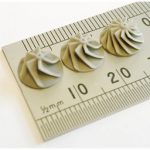Pipes, valves, and other flow components must withstand significant thermomechanical stresses, plus chemical exposure throughout service. But these factors are far from constant. Sharp temperature variations can induce brittleness. Abrupt mechanical stress can allow microcracks to propagate. Over time, these issues can precipitate microstructural changes that increase a material’s tendency to break under stress.
This is a critical concern in industries like oil and gas, chemical processing, and water treatment, where component integrity is essential for safe and efficient operation.
Crack Propagation
Ceramics are known for their susceptibility to crack propagation, unlike ductile materials, which can deform plastically under stress. This makes them prone to sudden and catastrophic failure. In flow systems, components are often subjected to various mechanical and thermal stresses. Even minor cracks in ceramic parts can quickly propagate, leading to unexpected component failure. This behavior is particularly problematic in flow systems where reliability and durability are paramount.
Sensitivity to Stress Concentrations
Another critical issue is the sensitivity of ceramic materials to stress concentrations. Stress concentrations often occur at sharp edges, corners, or around inherent material defects. These localized stresses can initiate cracks that rapidly spread through the material. In the dynamic environment of flow systems, such stress concentrations are nearly unavoidable, making ceramic parts particularly vulnerable. Engineers must consider these factors during design and manufacturing processes to mitigate the risks associated with stress concentrations.
Limited Resistance to Mechanical Stress
The brittle nature of ceramics implies a limited resistance to mechanical stress. Flow systems frequently experience pressure fluctuations, vibrations, and thermal cycling, all of which impose mechanical stresses on components. Due to their brittleness, ceramics cannot absorb or redistribute these stresses effectively, leading to a higher likelihood of failure. This limitation necessitates careful material selection and design to ensure the mechanical integrity of ceramic components under operational conditions.
Susceptibility to Thermal Shock
Thermal shock is another significant challenge for ceramic parts in flow systems. Rapid temperature changes can induce thermal stresses that ceramics, because of their brittleness, are poorly equipped to handle. When exposed to sudden temperature variations, the differential expansion or contraction within the ceramic material can cause cracking or fracture. This susceptibility underscores the importance of controlling thermal conditions and selecting materials with better thermal shock resistance for critical applications.
Reliability Concerns
The sudden and unpredictable nature of ceramic failures due to brittleness impacts the reliability and safety of flow systems. In applications where continuous operation is crucial, the unexpected failure of a ceramic component can lead to costly downtime and potential safety hazards. Therefore, enhancing the reliability of ceramic parts is essential for maintaining the overall efficiency and safety of flow systems.

Addressing Brittleness Issues
To mitigate the issues associated with the brittleness of ceramics in flow systems, several strategies can be employed:
Material Selection
Selecting ceramic materials with enhanced toughness or using ceramic composites can help reduce brittleness. Advanced ceramics and composites often incorporate materials that improve fracture toughness and resistance to crack propagation. For instance, silicon nitride (Si3N4), sialons, and zirconia are known for their improved toughness compared to traditional ceramics.
Design Optimization
Optimizing the design of ceramic components to minimize stress concentrations and distribute loads more evenly can significantly reduce the risk of brittle failure. Certain techniques can help in mitigating stress concentrations, like:
- Filleting sharp corners
- Reducing abrupt changes in cross-sectional areas
- Using gradual transitions.
Quality Control
Rigorous quality control processes during manufacturing can identify and eliminate components with potential defects that could lead to premature failure. Advanced inspection techniques, such as non-destructive testing (NDT), can detect internal and surface flaws. They ensure only high-quality components are used in critical flow systems.
Do Not Let Brittleness Affect Your Ceramic Parts
Brittleness remains a challenge for ceramic parts in flow systems. However ongoing research and development in advanced ceramics and manufacturing techniques continue to improve their performance and reliability. By carefully selecting materials, optimizing designs, and implementing stringent quality control measures, the risks associated with the brittleness of ceramics can be significantly mitigated, leading to more robust and reliable flow systems.
When you need to acquire advanced ceramics, we, International Syalons, will be here to help. Our ceramics, such as silicon nitride and zirconia, and relevant resources, including ones on manufacturing ceramics, are available to guide you in your choice. Take a look at our website. We are certain you will find a material that will work well in your application.
References
- Redwing R. So Why are Ceramics Brittle?. PennState College of Earth and Mineral Sciences. https://www.e-education.psu.edu/matse81/node/2156. Accessed 12th July 2024.
- Sample records for brittle ceramic materials. WorldWideScience. https://worldwidescience.org/topicpages/b/brittle%2Bceramic%2Bmaterials.html. Accessed 12th July 2024.



